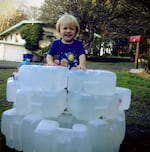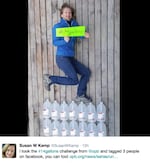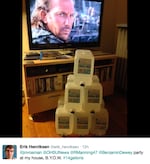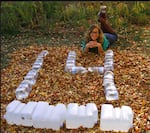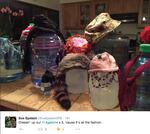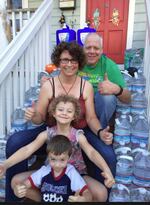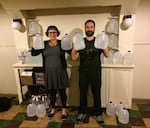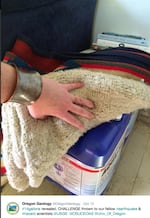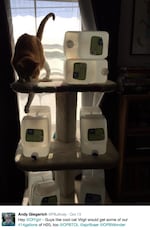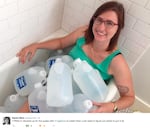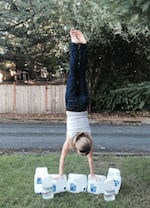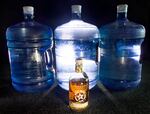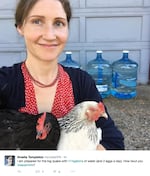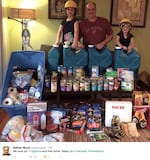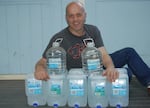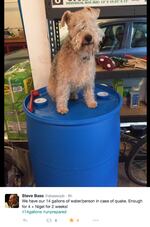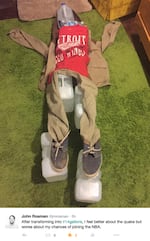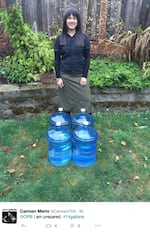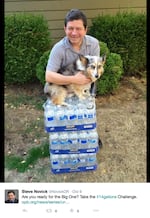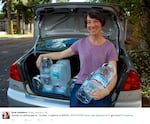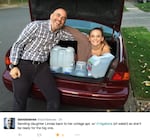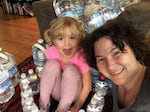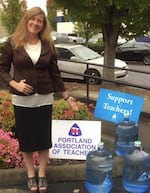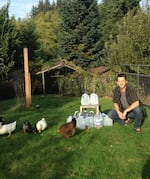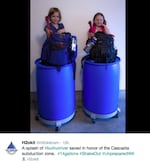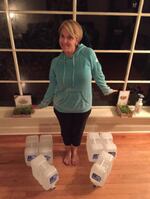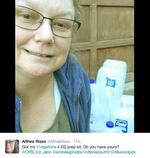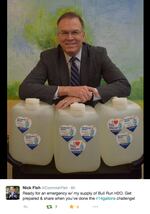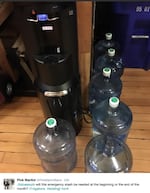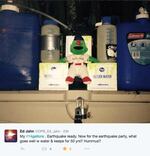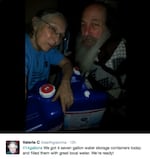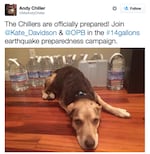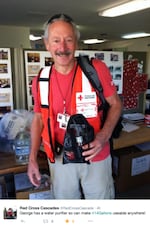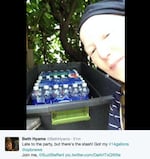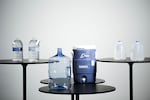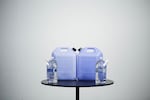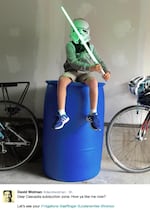
David Wolman
OPB has been reporting since January how Oregon is unprepared for the aftermath following a megaquake along the Cascadia Subduction Zone. Curious what could happen to you and your neighbors? Enter your address here. It can be a scary prospect, but preparing is easier than it may seem.
To that end, OPB is launching the #14gallons challenge.
We’ve learned through our reporting that most people think preparedness is canned food, not gallons of water. But here’s the catch, the average human can survive nearly three weeks without food — but only around 72 hours without water.
Related: How to secure water in your home after a disaster.
Here’s how you can participate.
1) Obtain 14 gallons of water.
2) Take a creative photo with it.
3) Post your photo online (Facebook, Twitter, Instagram) with the hashtag #14gallons, and challenge three of your friends to do the same.
If you already have your emergency water stored, take a creative photo with it and then repeat step three. Read below for information why each person needs 14 gallons and other frequently asked questions.
How Can You Possibly Take A Creative Photo With 14 Gallons Of Water?

OPB's Randy Layton and Katrina Sarson treat their 14 gallons of water with care, baby like care.
John Rosman / OPB
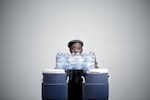
OPB digital producer Dave Stuckey has his 14 gallons so the sneaking earthquake doesn't catch him unprepared.
John Rosman / OPB

Digital producer John Rosman sees the lack of water in Oregonians' preparation kits as a big elephant in the room.
Tolu Adedipe / OPB

News reporter Amelia Templeton carries her 15 gallons of water with intrepid strength and care.
John Rosman / OPB
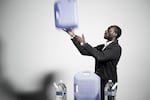
Digital service product owner Tolu Adedipe keeps his eye on making sure his 14 gallons of water are properly secured, up-to-date and stored.
John Rosman / OPB
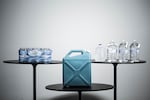
14 Gallons of water.
John Rosman / OPB
Why 14 Gallons Of Water?
One of the key steps to be prepared, according to the Red Cross, is for every house to have one-gallon of water — per person, per day — for two weeks. If the earthquake hits and it’s as big as leading geologists predict, then every person/family should be prepared to be on their own for that long.
Enter in your address and see what challenges you could face after the Cascadia Earthquake.
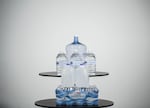
14 gallons of water
John Rosman / OPB
Where Do I Keep All Of This Water?
You want to keep water containers in a cool dark place. But, if your home was built before 1974 or if it isn't bolted to the foundation, it might be best to keep your supplies outside in a locked garbage can, storage container, supply shed, e.g.
Store it away from the sunlight, especially if you're bottling the water yourself. Sunlight can promote algae and bacterial growth.
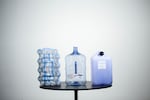
14 gallons of water.
John Rosman / OPB
What If I Live In A Tiny Apartment?
Store water however you can. The Portland Bureau of Emergency Management suggests dedicating part of a closet for water and emergency supplies, or finding space under sturdy furniture like a bed or desk.
You also might be able to use storage space in another part of your building, or ask nearby family, friends, or neighbors with more space to help you out.
"There is no magic bullet to answer this question. Every person’s situation will be different.," said Alex Roy a volunteer with the American Red Cross. "You just have to get creative...What I would simply recommend is that you do the best that you can with what you have. You may also consider talking to your landlord about emergency water storage for all tenants in another area of the building. "
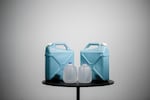
14 gallons of water.
John Rosman / OPB
Related: What critical infrastructure (schools, hospitals, fire stations) in your community is at risk
How Much Does This Cost?
That depends on where you buy the water and in what size. Online, for example, a full 5-gallon jug is around $20. You can also buy an empty 15-gallon plastic drum for around $45.
"I personally recommend buying commercially bottle water for the fact that it will keep longer and I will not need to change it every six months," said Roy. "You can buy a one gallon jug for $0.69 at many grocery stores. Thus, a two week supply of water for at least two years shelf time would cost approximately $10 per person."
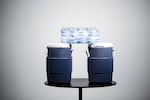
14 gallons of water.
John Rosman / OPB
14 Gallons Is Expensive! Can’t I Just Bottle My Own Water?
Yes! But if you bottle tap water, you have to go through a process to make sure it's safe to drink in the future. That's why emergency experts recommend buying it instead of bottling. If you store it yourself, experts recommend changing it out every six months.
Here are three very important factors to keep in mind for storing your own water. The notes below are taken from the Red Cross (PDF).
KNOW WHAT CONTAINER TO STORE WATER IN
Store in food-grade water storage containers or two-liter plastic soft drink bottles. Do not store in plastic jugs or cardboard containers that once housed fruit juice or milk. These containers can lead to bacterial growth with water stored in them. Glass also isn’t recommended since it’s fragile and gets really heavy.
CLEAN THE CONTAINER
Clean the container with dish washing soap and water. Make sure to get all the soap residue out. If you’re using a plastic soft drink bottle, sanitize the bottle by adding a solution of 1 teaspoon non-scented liquid chlorine bleach per quarter-gallon of water. Shake so it touches all surfaces.
After sanitizing, rinse out the sanitizing solution with clean water.
PROPERLY STORE THE WATER
If you get tap water, you can fill it without doing anything else. If you get water from a well or a water source not treated with chlorine, add two drops of non-scented liquid household chlorine bleach for each gallon of water.
Tightly close the container using the original cap. Write the date on the outside of the container. Store in a cool, dark place. With water you store yourself, you need to replace every six months.
I Still Need Help
Have more questions? Shoot us an email!
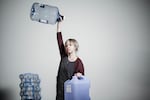
Digital producer Ann McGarry holds her 15 gallons of water like a true preparation champion.
John Rosman / OPB
